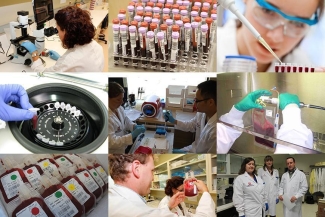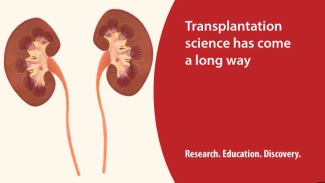A searchable database showcasing our funded research projects has just been launched on blood.ca. Together with our publications database, research highlights, links to this blog, research units and other news, you’ll discover a knowledge hub for the transfusion and transplantation community.
Blood and transfusion research has a long history: from the early days of transfusion medicine to military initiatives that deliver much-needed transfusion to the battlefield to that closer-to-home research that enables advances in patient care, increases clinical knowledge and enhances blood safety.
Canadian Blood Services supports world-class, mission-driven innovation through its researchers and collaborative networks. Exploratory and applied studies uncover new information to develop best practices in transfusion and transplantation medicine.
For those curious about this work, you can find out a bit more about the research that goes on behind the scenes. Research Units are an excellent resource, and this blog, celebrating one year of research, education and discovery stories is also a great place to start. Here’s a roundup of a few research stories from the last year.

Safety matters
It’s important that blood products used in treatment don’t make the recipient’s condition worse, either through adverse reactions or infection. It’s also important not to cause harm to the donor. The following studies involving Canadian Blood Services researchers are examples of how research aims to make transfusion safer for everyone.
- Curious about the effect of storage on blood products, researchers looked at the effect that different plasticizers had on red blood cells. They compared storage bags made with different materials and found the best combination for storing red blood cells for safe transfusion.
- Blood operators rely on many safeguards to prevent contaminated blood from reaching transfusion patients and to protect the health of donors. Implementing screening questionnaires for donors at the point of collection and filtering out white blood cells are among the steps taken. Ongoing research keeps processes and procedures efficient and effective.
- Researchers found that Dengue, a mosquito-borne virus could hide away and multiply in platelets during storage. Operators use research like this inform how to protect against known and emerging pathogens.
- Donor safety is also top of mind. A recent study found that some donors have low levels of ferritin, a blood protein marker of the body’s iron stores. Ferritin levels also predicted an inability to donate in the future due to reduced hemoglobin. To help donors stay healthy, study participants with low ferritin levels were advised to visit their doctor for further investigation. Based on this research, eligibility requirements for donors were changed.
Efficiency matters
Blood components are tricky materials to store safely and effectively after collection. Research on improving storage conditions and extending shelf life helps reduce waste and maximize the supply without compromising patient safety.
- Platelets are currently only viable for up to five days in storage. They require constant agitation at room temperature so they don’t clot in the bag. These storage conditions also increase the risk of bacterial contamination. However, research shows that platelet additive solutions instead of traditional plasma might safely extend platelets’ shelf life.
- Paradoxically, in addition to protecting patients, safety protocols may also cause waste of products. However, researchers found out that it is safe to double the traditional 30-minute time limit for holding red blood cells out of controlled storage. This helps clinical staff manage a patient’s transfusions more efficiently in a busy hospital setting without worrying about supply and waste.
- Ongoing research into post-collection processing identifies ways to prevent cell damage. This helps blood stocks remain viable in storage for longer periods, as well as improving the value of transfusions to patients.
- Continual review processes identify best practices, ensuring that only the patients that will benefit from transfusion receive it.
Innovation matters
Innovation requires research, and developing best practices and introducing new equipment require thorough evaluation for safety, efficiency and benefit. Blood donated to netCAD is often used to test out new equipment. It can also go to researchers investigating new treatments or developing new tools.
- Adding new, closed-system cell-washing equipment into red blood cell treatment protocols extended product storage time and improved treatment effectiveness for patient safety.
- Researchers developed ThromboLUX, a laser device that uses light and Doppler shift characteristics to scan units for platelet quality. Easy to use, it can monitor platelets at production, or be used at the bedside to help clinicians choose the most suitable product for patients.
- Megakaryocytes, which produce platelets, are useful in blood research. However, they are difficult to source and grow in the lab. Producing them from a human peripheral blood source would make studying them much easier.
- To help patients requiring intravenous immunoglobulin (IVIg), a plasma protein drug used to treat immune disorders, researchers are developing a test, called the monocyte monolayer assay, to help identify patients at risk of IVIg-associated hemolysis.
- On the transplant side, the Canadian cPRA Calculator, a recent innovation by a team of Canadian Blood Services researchers and the National HLA Advisory Committee, improved the situation for Canadian transplant patients.
Want to read more?
Stay tuned as we put this first year of sharing research behind us and prepare for more research, education and discovery…
Related blog posts
Mice are small, easy to handle and available as consistently bred individuals with little genetic variation – this makes them ideal for research. Furthermore, they share between 70 per cent and 90 per cent genetic make up, undergo many of the same life events that humans do, possess a similar anatomy (OK – mouse-shaped) and show similar physiology to us. A mouse offers a whole living organism in which to investigate disease, response to treatment, development of cancer and other basic research.
Transplanting organs, tissue or stem cells from one person to another saves lives. It was not easy to figure out what facilitates a healthy and successful transplant though. Efforts over a long time reveal the complexity of the procedure and that very specific circumstances are required. As researchers’ understanding of the immune system improved, so did the success rate of transplants.

